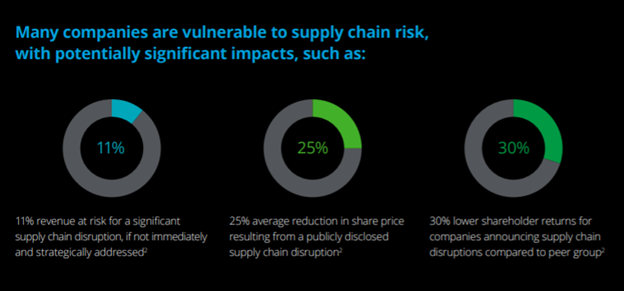- Blog
- Pharma and Biotech Supply Chain Risk. Solution: Automation
Pharma and Biotech Supply Chain Risk. Solution: Automation
Pharmaceutical and biotechnology (biopharma) businesses are feeling the pressure to keep up with supply chain risk. To compete with the extra pressure to demonstrate the value of its products and meet rising customer expectations, organisations need to invest in technology that allows them to become insights-driven to continuously improve the P2P process. Read how automation and intelligent technologies are key to doing so in this blog.
It’s a four-letter word—risk. And it’s become an even more important concept in the current climate, especially when considering biopharma supply chain risk. As businesses, we spend much of our time mitigating risk to the best of our abilities, keeping company information secure, and ensuring visibility across processes so that nothing goes overlooked.
When it comes to modern biopharma organizations, the traditional rules of risk and supply chain management still apply—but the stakes are higher than ever. Biopharma supply chain risk continues to increase as more digital processes become the norm for streamlining and strengthening risk management.
Lack of supply chain visibility
A lack of supply chain visibility and creativity leaves biopharma organisations at risk for things such as:
1. Disruption: Pandemics (such as what we’re currently dealing with), earthquakes, floods, wildfires, hurricanes, all cause a sudden disruption in the natural flow of supply chains. Not to mention, trade wars, labor disputes, and politics can also create disruption. Without supply chain visibility, organisations affected by these disruptions may not be equipped with a disaster recovery plan.
2. Interruptions: Lack of visibility into the supply chain can cause companies to lose track of their supply network. If you don’t have the technology that permits you to forecast demand, you could be left with not enough or too much inventory at different points in your supply chain.
3. Bad data: Data is one of the most important aspects of your supply chain. But if you don’t have full visibility into that data or if that data is spread across disparate systems, you’ll lack the insights needed to do things such as create unity in your supply chain, increase collaboration, and predict challenges.
4. Wrong suppliers: Now more than ever, biopharma organisations are under scrutiny with who they do business with. Greater supplier visibility is becoming a vital part of business as ethical standards and brand alignment heighten in importance.
Biopharma and supply chain complexities
2020 has been an interesting year for pharma and biotech companies. They have been dealing with tremendous growth, while at the same time trying to minimize disruptions to global processes and mitigate risk in the global supply chain.
According to Deloitte, “Disruptions to global supply chains due to COVID-19 have been heavy. Free movement and operation of people, raw material, finished goods, and factory operations have been stymied. Direct supply chains (i.e. Tier 1 vendors) have experienced challenges, and so have extended supply chain partners such as third-party and fourth-party vendors—the suppliers of suppliers.”
Biopharma companies are even more vulnerable to the dangers of supply chain risks. Their services are both high-value and high-impact. Biopharma supply chains are extremely complex with rising customer expectations for transparency, the demand for faster production times of vaccines, and the need to deliver ground-breaking medical treatments worldwide. Due to their complex nature, these companies need total visibility over their supply chains and increased visibility into who they transact with.
Cerasis supports the idea that these supply chains won’t decrease in complexity anytime soon. The digital era has only increased the tendencies for them to continue to increase in complexity. They state that “As the supply chain continues to grow in complexity and regulation, the opportunities for problems and other events to impact operations negatively will consequently grow. As a result, supply chain entities need to understand how risk management and resiliency apply to both good and bad situations and how an organisation can improve supply chain risk management and resiliency processes.”
Tackle supply chain risk with automation
Automation is the answer. It brings transparency to the actions of all parties within your supply chain, supporting an effective biopharma supply chain strategy. While it doesn’t eliminate risk entirely, automation adds a layer of visibility that helps proactively identify areas where risk may be present. Supply chain leaders can then use this insight to detect current or potential issues before they escalate.
In a recent report we created in collaboration with Harvard Business Review Analytic Services (HBRAS), 779 global executives shared their perspectives on the future business landscape. Transparency emerged as the primary barrier to achieving more visible finance and procurement functions. Ninety percent of executives agreed that greater business transparency leads to better-informed decision-making across the entire organization, while 60 percent believe poor visibility directly contributes to supply chain risk. Nearly one-quarter admitted they fail to effectively evaluate supplier business practices as part of their risk prevention and management—further underscoring the growing importance of a strong biopharma supply chain strategy.
To achieve the highest level of supply chain transparency, you need the right technologies. You can’t possibly expect to keep track and keep safe all the nuances of your supply chain manually. With all the working pieces, digital, intelligent technologies are a surefire way to properly manage and identify risk and fraud. With a comprehensive supplier management solution, biopharma companies gain visibility into 100% of suppliers and spend, enabling exceptional risk mitigation.
Supply chain visibility is all about transparency—knowing where goods are at any given time, tracking movement, delivery, and thoroughly understanding who you’re doing business with. At Basware, we call this “visible commerce.” Visible commerce is the complete transparency into all the flows of money, goods, and services around the world. This refers not only to the transactional transparency of things like buying, selling, and paying transactions, but also much more holistic transparency into who (not what) is underneath all those transactions, what they stand for, and why we should care.
With the right automated tools built specifically to improve supply chain visibility, your biopharma company can:
1. Decrease business disruptions: Prepare for supply chain disruptions before they even happen. When your supply chain operates with a strong foundation on data analysis and open lines of communication, you decrease supply chain bottlenecks and even avoid disruptions entirely.
2. Drive your business with data: Manually updating supplier information leads to obsolete data, potential risks, and wasted time. Basware solutions deliver 100% visibility into your entire supply chain, delivering the benefits of complete supply chain data. Processing this data through Basware empowers you with the insights you need to make smart, data-based decisions that will lead to supply chain excellence.
3. Team up with the right suppliers: Your suppliers are an extension of your brand. So, it’s important to ensure you’re doing business with the right suppliers who align with you ethically, meet your price requirements, offer the right experience, can meet your orders, and are financially stable. Having the right supply chain technology can guarantee your suppliers check all those boxes.
Get more industry-specific assets
Want more on how you can make your biopharma business stronger, more resilient, and streamlined? Visit our dedicated biopharma webpage where you can find other useful blogs, a Roadmap to Business Transformation, a factsheet, and more.
Subscribe to the Basware Blog!
Related
-
By Basware RepresentativeUnveiling CFO Strategies for Long-Term Value Creation – Webinar Insights
-
By Anu HämäläinenUnlocking AI in Finance: The Invoice Ingestion Revolution
-
By Christopher BlakeComplexity to Clarity: Forrester's Expert Take on AP Invoice Automation
-
By Christopher BlakeChoosing AP Excellence: Finding the Right Solutions Amid S2P Suite Challenges
-
By Basware RepresentativeUnlock the Power of Invoice Digitalization: Watch Our On-Demand Webinar Now!
-
By Basware RepresentativeAP Metrics that Matter – Webinar with Ardent Partners
-
By Sanna EklundHarnessing AI and ML to Transform AP
-
By Basware RepresentativeTouchless Invoice Processing – the Future of High Performing Finance Teams



